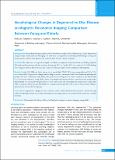Please use this identifier to cite or link to this item:
https://hdl.handle.net/20.500.14356/1718Full metadata record
| DC Field | Value | Language |
|---|---|---|
| dc.contributor.author | Panta, O B | - |
| dc.contributor.author | Songmen, S | - |
| dc.contributor.author | Maharjan, S | - |
| dc.contributor.author | Subedi, K | - |
| dc.contributor.author | Ansari, M A | - |
| dc.contributor.author | Ghimire, R K | - |
| dc.date.accessioned | 2023-05-19T06:12:42Z | - |
| dc.date.available | 2023-05-19T06:12:42Z | - |
| dc.date.issued | 2015 | - |
| dc.identifier.citation | PantaO. B., SongmenS., MaharjanS., SubediK., AnsariM. A., & GhimireR. K. (2016). Morphological Changes in Degenerative Disc Diseaseon Magnetic Resonance Imaging: ComparisonBetween Young and Elderly. Journal of Nepal Health Research Council. https://doi.org/10.33314/jnhrc.v0i0.674 | en_US |
| dc.identifier.issn | Print ISSN: 1727-5482; Online ISSN: 1999-6217 | - |
| dc.identifier.uri | http://103.69.126.140:8080/handle/20.500.14356/1718 | - |
| dc.description | Original Article | en_US |
| dc.description.abstract | Abstract Background: Morphological changes implicated in low back are complicated by additional age related degenerativechanges in spine, which increases with aging. This study aims to compare the morphological MRI findings in young andelderly patients with low back pain and also correlate them with the clinical symptoms. Methods: The study was a retrospective hospital record based comparative study carried out in a Teaching Hospital.MRI performed for patients with low back pain during May 2012 to October 2012 were reviewed. The MRI findings were compared between below 60 years and at and above 60 years and were also correlated with symptoms. Results: A total of 301 MRI met the inclusion criteria out of which 228(75.74%) were young adults and 73(24.25%)were elderly adults. Degenerative changes and disc bulge was more common in elderly. Disc herniations including discprolapse was more common in young adults. Disc protrusion involving L4-L5 was most common in the elderly whileL5-S1 was most common in young adults. Nerve root compression was noted more commonly in the young adults.Radiculopathy was associated with grade III nerve root compression and paramedian disc protrusion in young adultswhile no such association was noted in elderly. No association of radiculopathy with presence of degenerative changes,spinal stenosis was noted in both groups. Conclusions: Degenerative changes are more common in elderly while disc herniations are more common in youngadults. Morphologic changes do correlate with symptoms in young adults to some extent while they do not correlatein elderly. | en_US |
| dc.language.iso | en_US | en_US |
| dc.publisher | Nepal Health Research Council | en_US |
| dc.relation.ispartofseries | Sep-Dec, 2015;674 | - |
| dc.subject | Â Degenerative disc disease | en_US |
| dc.subject | Elderly | en_US |
| dc.subject | Low back pain | en_US |
| dc.subject | Magnetic resonance imaging | en_US |
| dc.subject | Young adults | en_US |
| dc.title | Morphological Changes in Degenerative Disc Diseaseon Magnetic Resonance Imaging: ComparisonBetween Young and Elderly | en_US |
| dc.type | Journal Article | en_US |
| local.journal.category | Original Article | - |
| Appears in Collections: | Vol. 13 No 3 Issue 31 Sep-Dec 2015 | |
Files in This Item:
| File | Description | Size | Format | |
|---|---|---|---|---|
| 674-Article Text-1264-1-10-20160317.pdf | Full text Article | 171.27 kB | Adobe PDF |  View/Open |
Items in DSpace are protected by copyright, with all rights reserved, unless otherwise indicated.
